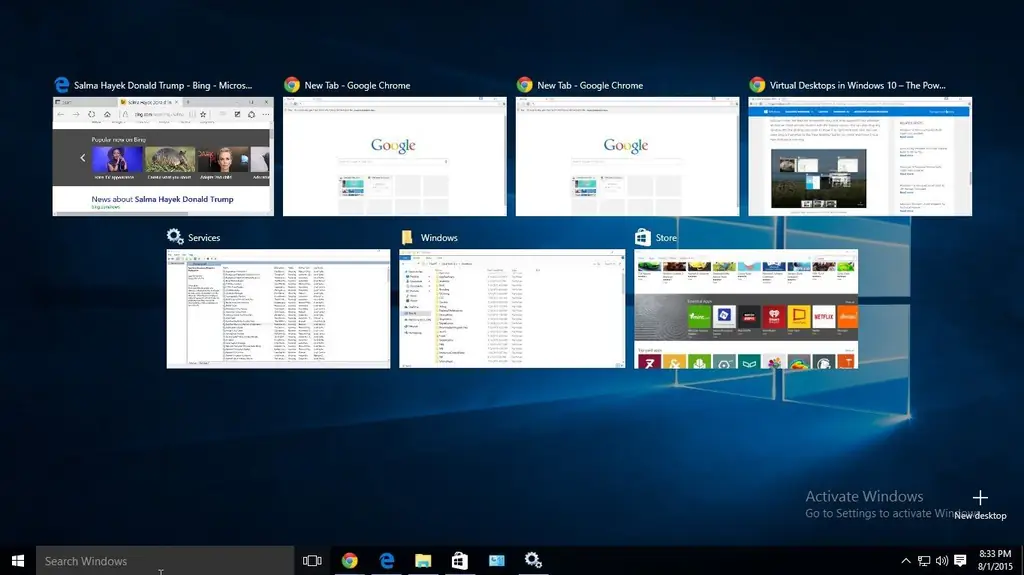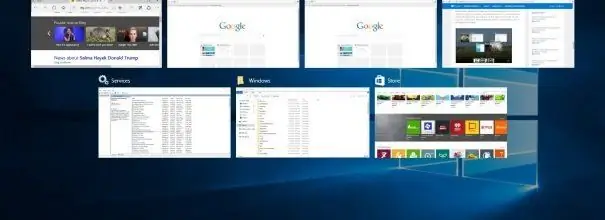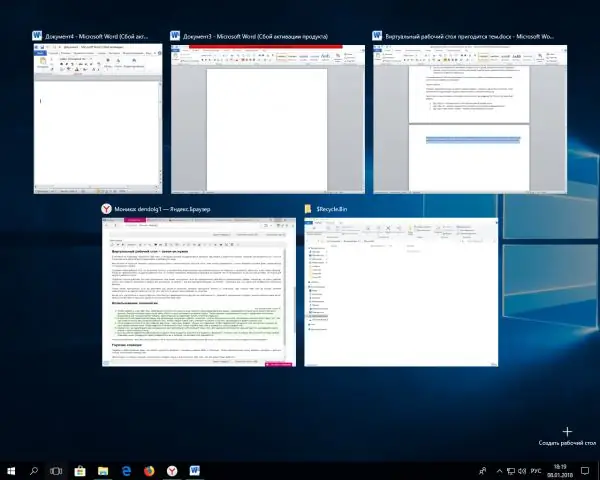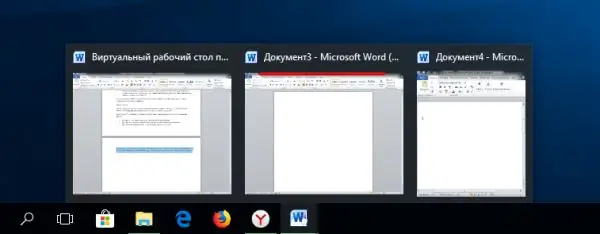
Table of contents:
- Author Bailey Albertson [email protected].
- Public 2023-12-17 12:53.
- Last modified 2025-01-23 12:41.
Windows 10 virtual desktops and how to use them

The virtual desktop is useful for those who are used to working with many programs, files or folders at the same time. Thanks to him, it becomes possible to organize and divide the elements into as many groups as needed.
Why you need a virtual desktop
Windows 10 introduces Task View technology, which controls windows and desktops. Its convenience lies in the fact that all open windows are evenly spaced when unfolded.

All open programs and documents in Task View are presented in the form of maximized windows, but smaller
You no longer have to hover the cursor over a group of windows in the quick access panel, wait for the list to expand, and then select the desired file, focusing on the small window.

Selecting the desired window using the standard window view is not as convenient as using the Task View
By creating a new desktop, you get a system in which all previously open applications are open, but minimized and invisible.
A similar system works for all applications. It can come in handy if you are simultaneously working in a variety of fields. For example, on one desktop, programs and files for drawing are open, on the second - everything for programming, on the third - everything that is necessary for comfortable watching a movie.
With Task View, you can quickly switch from one desktop to another if you don't want anyone else to see what documents you are opening or what projects you are working on. This feature also allows you to move, close, or delete open applications as needed.
Use of technology
To use Task View, follow these steps:
-
Click on the triple window icon (Task View) on the left side of the Quick Access Toolbar. It is located immediately after the Start menu and the magnifying glass of the search system bar. Also, the transition to virtual tables and their management can be carried out using hot keys, discussed in the next paragraph "Hot keys".

Task View icon in the taskbar Click on the "Task View" icon
-
The upper block of the screen contains all running programs and files, the lower one contains a list of virtual tables. Initially, the bottom list will be empty since there is only your main desktop. To create a new table, click on the plus button located in the lower right corner.

New Desktop Button Click on the plus icon to create a new desktop
-
After clicking the button, two tables will appear in the list - one is yours, the second is just created. To switch to another table, just click on it with the left mouse button. To return to the start table, open Task View again and select the first table in the list.

Two desktops in Task View Select the desired table in the list and click on it to open
-
By deleting a table, you move all applications running in it to the table closest to the left. To remove, use the red cross next to the table icon in the lower list.

Deleting Desktop in Task View Click on the cross to remove the table
-
If you want to move an application from one table to another, grab it with the mouse and drag it to the desired table in the list. Or click on it with the right mouse button, expand the "Move to" line and specify the table to move to.

"Move to" item in the context menu of an open window Select the "Move To" function to move the desired application to another desktop
This is where the possibilities of Task View end. But the technology contains all the necessary functions, they will be enough for comfortable use.
Video: How to use virtual desktops in Windows 10
Hotkeys
Once in the task view, you can control the selection using the Enter key and the arrow keys. Use the Tab key to switch between the selection of programs and desktops.
There are also hotkeys that can be used outside the open Task View, they will still work:
- Win + Ctrl + D - activation of a new table and automatic transition to it;
- Win + Ctrl + F4 - delete the current table and automatically switch to the previous table;
- Win + Ctrl + left / right arrow - move between the existing tables.
Video: how to use virtual desktops with keyboard shortcuts in Windows 10
Virtual tables are useful when you need to split open applications and files into groups. The Task View function will make it easier to work at the computer and ensure its high speed and efficiency.
Recommended:
How And How To Seal The Seams Between Drywall Sheets With Your Own Hands

How to properly putty the seams at the joints of drywall sheets. Materials and tools used. Step by step description of the process
Chamora Turusi Variety Of Garden Strawberries - Features, Care And Other Important Aspects, The Difference Between Strawberries And Garden Strawberries + Photo

Everything about the Chamora Turusi strawberry variety: from planting and care to picking berries. Productivity, terms of fruiting, reviews of gardeners
What Is The Difference Between The IPhone 6 And 6s And Plus, Which Is Better

Comparison of smartphones Iphone 6, 6s and 6+. Which model is better to buy. User reviews
Roof Ventilation, Its Elements And Purpose, As Well As How To Correctly Calculate And Organize

Factors that determine the need for a roof ventilation device. Types of ventilation elements, their design features and methods of application
Metal Roof Ventilation, Its Elements And Purpose, As Well As How To Correctly Calculate And Organize

Ventilation means for the under-roof space. Installation of additional ventilation devices. Calculation of ventilation of metal roofing
